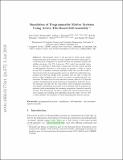Simulation of Programmable Matter Systems Using Active Tile-Based Self-Assembly
Author(s)
Demaine, Erik D
DownloadSubmitted version (1.567Mb)
Open Access Policy
Open Access Policy
Creative Commons Attribution-Noncommercial-Share Alike
Terms of use
Metadata
Show full item recordAbstract
Self-assembly refers to the process by which small, simple components mix and combine to form complex structures using only local interactions. Designed as a hybrid between tile assembly models and cellular automata, the Tile Automata (TA) model was recently introduced as a platform to help study connections between various models of self-assembly. However, in this paper we present a result in which we use TA to simulate arbitrary systems within the amoebot model, a theoretical model of programmable matter in which the individual components are relatively simple state machines that are able to sense the states of their neighbors and to move via series of expansions and contractions. We show that for every amoebot system, there is a TA system capable of simulating the local information transmission built into amoebot particles, and that the TA “macrotiles†used to simulate its particles are capable of simulating movement (via attachment and detachment operations) while maintaining the necessary properties of amoebot particle systems. The TA systems are able to utilize only the local interactions of state changes and binding and unbinding along tile edges, but are able to fully simulate the dynamics of these programmable matter systems.
Date issued
2019-11Department
Massachusetts Institute of Technology. Department of Electrical Engineering and Computer ScienceJournal
Lecture Notes in Computer Science (including subseries Lecture Notes in Artificial Intelligence and Lecture Notes in Bioinformatics)
Publisher
Springer International Publishing
Citation
Alumbaugh, John Calvin et al. “Simulation of Programmable Matter Systems Using Active Tile-Based Self-Assembly.” Lecture Notes in Computer Science, 11648 (November 2019): 140-158 © 2019 The Author(s)
Version: Original manuscript
ISSN
0302-9743